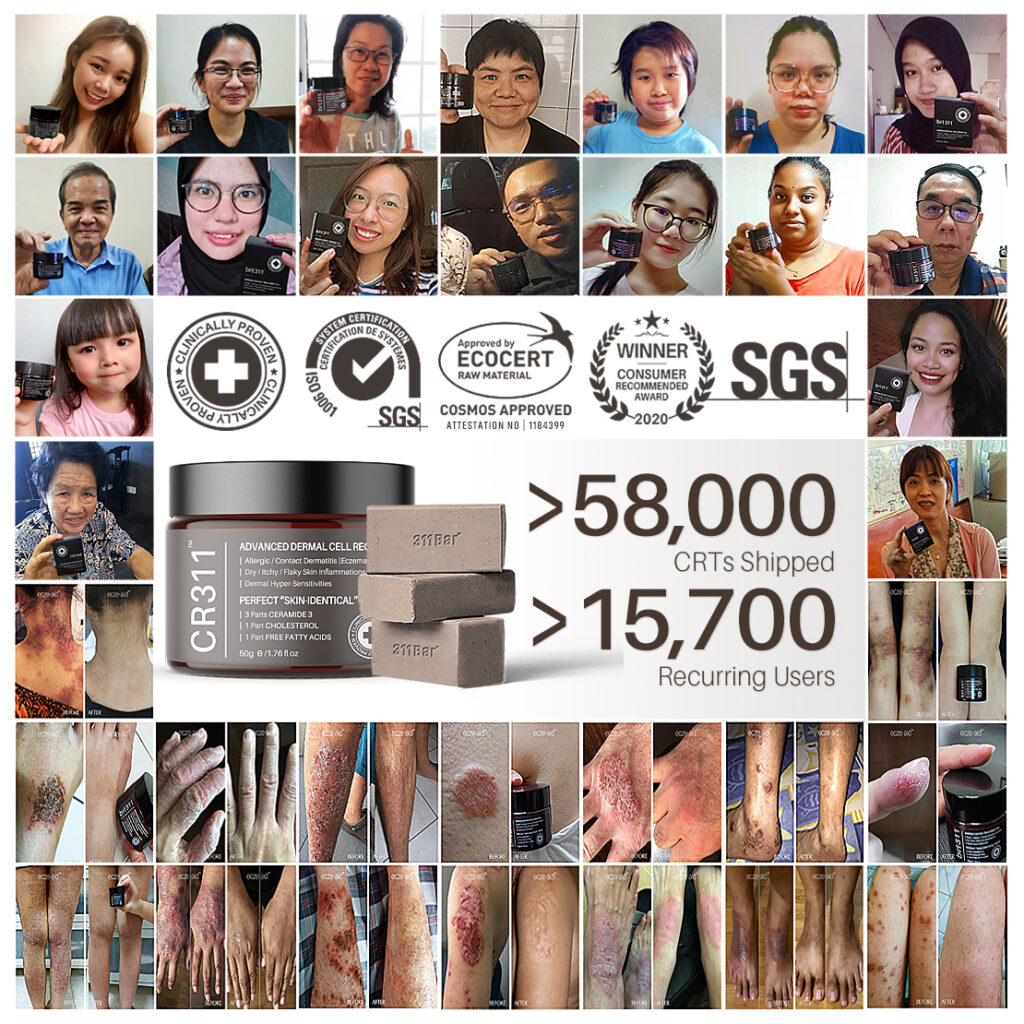UNDERSTANDING
THE SCIENCE
CR311™ is a ceramide-dominant, 3:1:1 ratio formulation which addresses THE KEY FACTOR that causes dry-itchy skin and dermal hyper-reactivity ▸ a DEFECTIVE EPIDERMAL BARRIER.
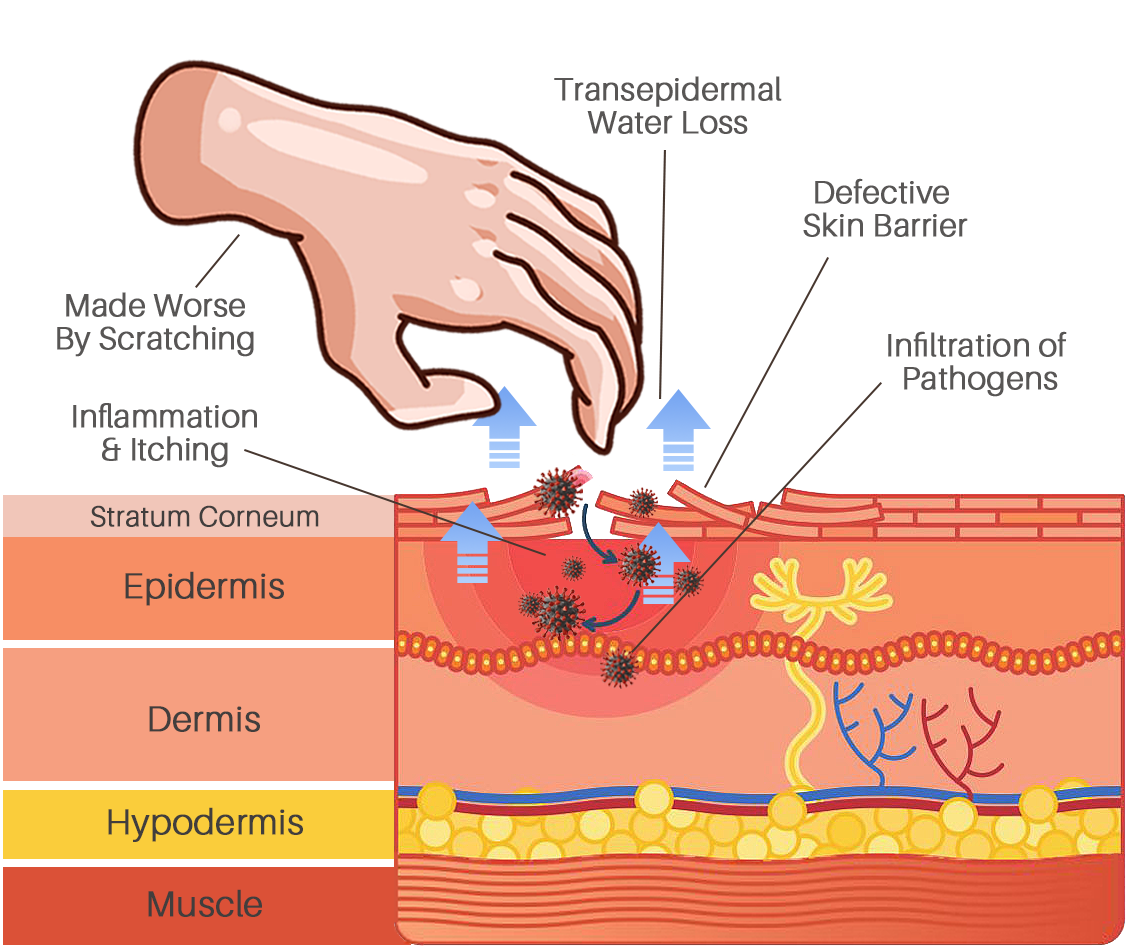
Repairing Skin Barrier is KEY to Treating Eczema
Up until very recently, the cause of eczema has been largely misunderstood – a generally accepted explanation had always been an imbalanced immune system. Fortunately, recent ground-breaking research pinpointed that skin protein filaggrin deficiency and a defective skin barrier are key factors that trigger this insufferable skin problem.
With a malfunctioning barrier, the skin dehydrates and becomes parched due to water loss and is greatly susceptibility to inflammation triggered by pathogens, irritants and allergens.
The skin fundamentally serves as a protective barrier between hostile aggressors and the host. While the skin has many important barrier functions, the two that are absolutely essential for survival are the barrier to the loss of water and the barrier against invasive & toxic microbes. LIPIDS, composed primarily of ceramides, cholesterol and free fatty acids play an indispensable role as a bonding agent in the structural integrity of both these barriers.
The PERFECT 3:1:1 Ratio
In the skin’s natural architecture, the ceramides slot in between the cholesterol & free fatty acids molecules, forming a fluid & elastic intercellular “cement” which keeps the skin’s “bricks”, intact.
This structure is achieved only if each element is in the right quantity & the right ratio. Even the slightest variation in the proportions can bring about significant effect on its functionality, leading to a dysfunctional barrier and an increase in transepidermal water loss [TEWL].
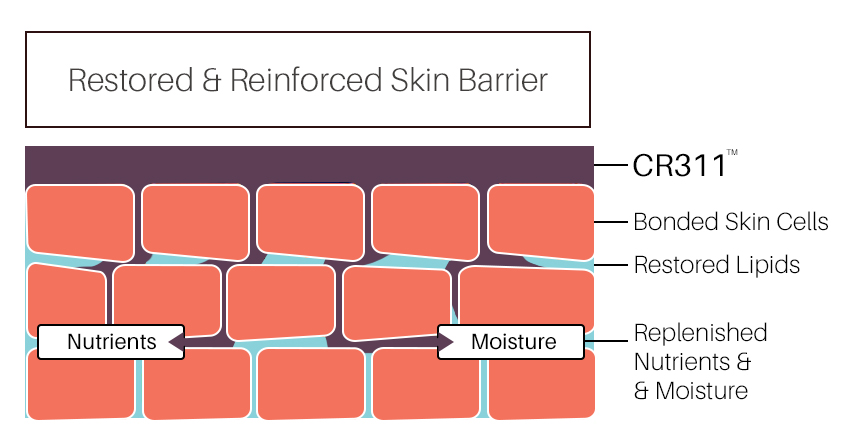
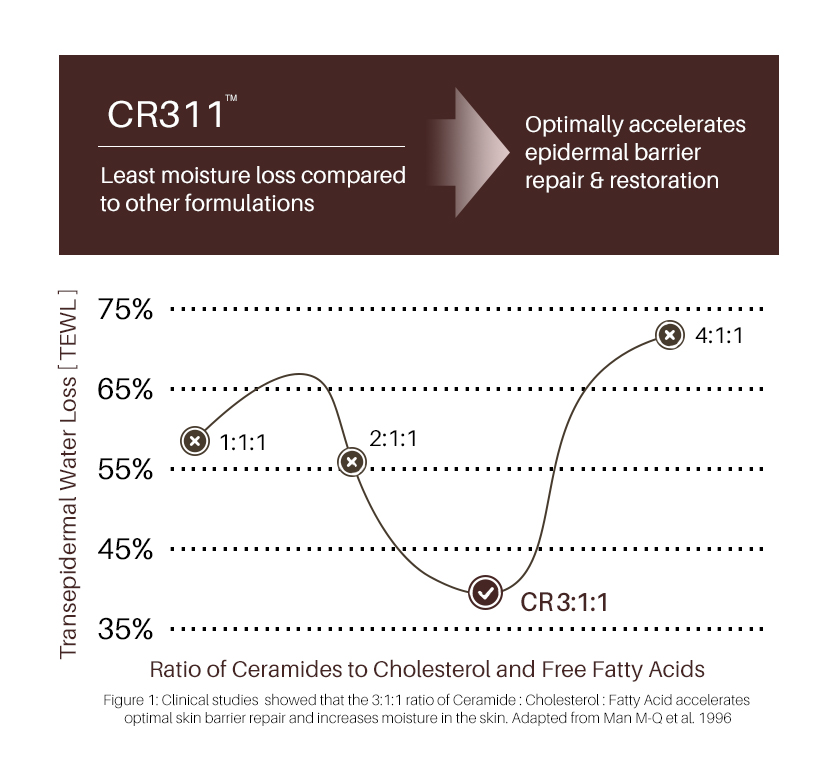
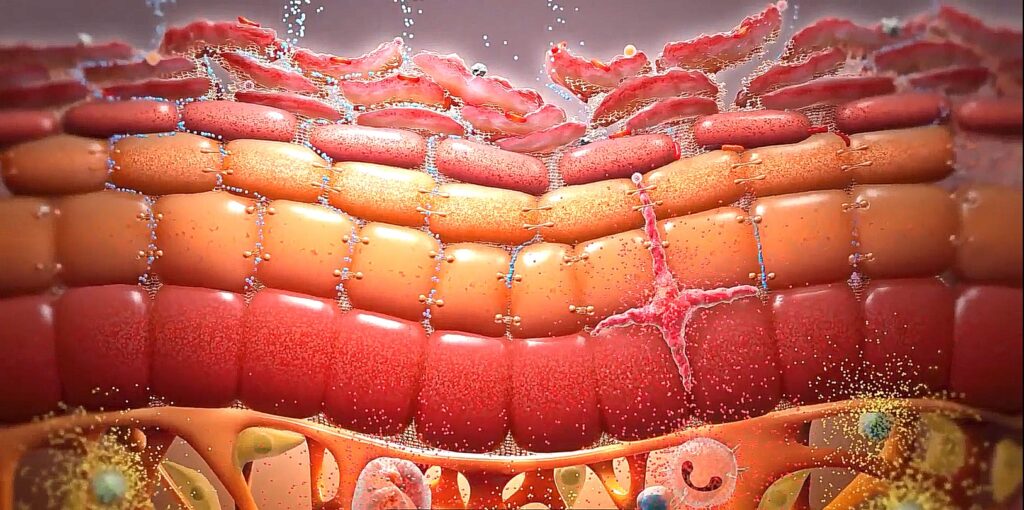
Treating The ROOT CAUSE with CR311™
CR311™ is a specialized & medically developed, 3:1:1 ratio formulation to treat the true pathophysiology of skin dermatitis, one that is complex & multifactorial – involving elements of barrier dysfunction, alterations in cell mediated immune responses, IgE mediated hypersensitivity & environmental factors. It perfectly mimic your skin’s epidermal barrier composition which yields the highest efficacy – containing only Medical-Grade, Clinically-Proven & EWG Verified™ ingredients, featuring:
———————-
🔸 3 parts of CERAMIDE 3
🔸 1 part of Cholesterol
🔸 1 part of Free Fatty Acids
———————-
COMMON TYPES OF DERMATITIS
Atopic dermatitis is the most common form of chronic eczema. Atopic refers to an allergy. This condition occurs in flare-ups or bouts, meaning that it gets worse and improves in irregular cycles.
SYMPTOMS
- The rash often forms in the creases of elbows or knees.
- Skin in areas where the rash appears may turn lighter or darker, or get thicker.
- Small bumps may appear and leak fluid if scratched.
- Babies often get the rash on their cheeks and scalp.
- Skin can get infected from scratching.
CAUSE
- Atopic dermatitis happens when your skin’s natural barrier against the elements is weakened. This means your skin is less able to protect against irritants, allergens or pathogens. It may also be caused by a combination of factors such as genes, skin dryness, weak immune system and environmental triggers.
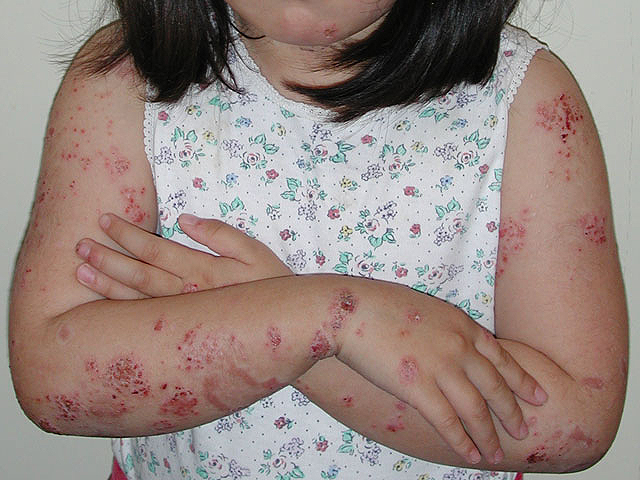
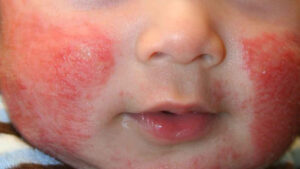
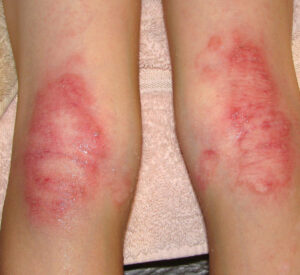
Only affects the hands when regularly exposed to chemicals that irritate the skin.
SYMPTOMS
- Your hands get red, itchy and dry.
- They may form cracks or blisters.
CAUSE
- Hand eczema is triggered by exposure to chemicals and often affects people who work in jobs like hairdressing, healthcare, laundry and cleaning.
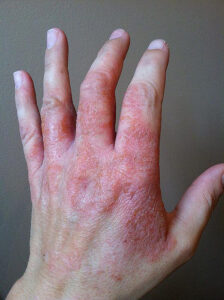
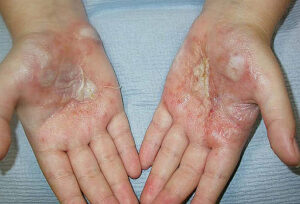
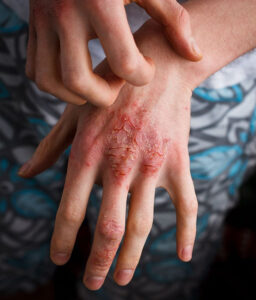
Lip dermatitis or eczematous cheilitis, causes a characteristic redness, drying, and scaling of the lips.
SYMPTOMS
- Red rash on or around the lips
- Dryness or flakiness
- Split or scaly skin
- Itching, burning inflammation
CAUSE
- Irritant contact cheilitis occurs as a result of external irritation, such as lip licking, cosmetics, and environmental factors.
- Allergic contact cheilitis is an allergic reaction to lip products, dental materials, toothpaste, or medication.
- Angular cheilitis develops due to a fungal infection, usually Candida, or a bacterial infection. Angular cheilitis is common in people with diabetes.
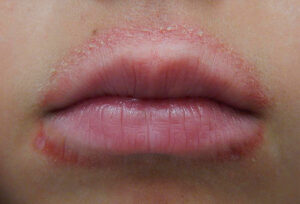

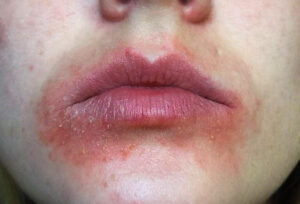
Seborrheic dermatitis is a common, noncontagious, skin condition. This type of dermatitis causes itchy red patches and greasy scales on your skin along with white or yellow crusty or powdery flakes on your scalp.
SYMPTOMS
- Skin flakes on your scalp, hair, eyebrows, beard, or mustache.
- Patches of greasy skin covered with flaky white or yellow scales or crust on the scalp, face, sides of the nose, eyebrows, ears, eyelids, chest, armpits, creases of genitals/groin or under the breasts.
- Itching
CAUSE
- An inflammatory reaction to a type of yeast – Malassezia. The yeast overgrows and your immune system overreact to it, leading to an inflammatory response. Common triggers include stress, oily skin, hormonal changes, illness, soaps, dry weather, medications etc.

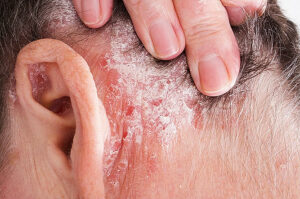

A reaction when in contact with specific substance[s] and comes in two types: 1. Allergic Contact Dermatitis – an immune system reaction to an irritant like latex or metal; 2. Irritant Contact Dermatitis – when a chemical or other substance irritates your skin.
SYMPTOMS
- Your skin itches, turns red, burns and stings.
- Itchy bumps called hives may pop up on your skin.
- Fluid-filled blisters can form that may ooze and crust over.
- Over time, your skin may thicken and feel scaly or leathery.
CAUSE
- Contact dermatitis happens when you touch a substance that irritates your skin or causes an allergic reaction. The most common causes are detergents, bleach, jewelry, latex, nickel, paint, poisonous plants, skin care/cosmetic products, soaps and perfumes.
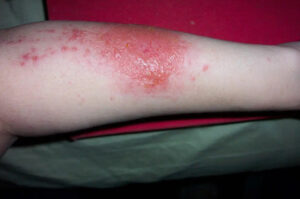

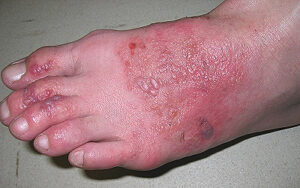
This causes tiny blisters to form on your hands and feet. It’s more common in women than men.
SYMPTOMS
- Fluid-filled blisters form on your fingers, toes, palms and soles of your feet.
- These blisters may itch or hurt.
- The skin can scale, crack and flake.
CAUSE
- Dyshidrotic eczema can be caused by allergies, damp, sweaty hands and feet, exposure to substances such as nickel, cobalt, or chromium salt and stress.
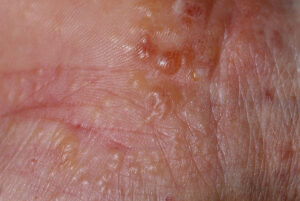
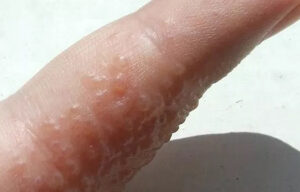
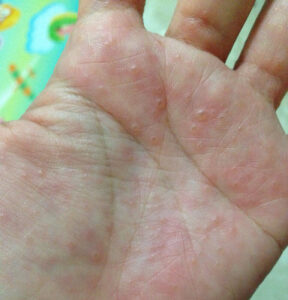
Neurodermatitis starts with an itchy patch of skin. Scratching makes it even itchier. This itch-scratch cycle causes the affected skin to become thick and leathery.
SYMPTOMS
- Thick, leathery patches form on your arms, legs, back of your neck, scalp, bottoms of your feet, backs of your hands or genitals.
- These patches can be very itchy, especially when you’re resting or asleep.
- If you scratch the patches, they can bleed and get infected.
CAUSE
- Researchers are still unsure exactly what causes it, although stress and anxiety are likely triggers. The persistent scratching that characterize the condition may begin with something that simply irritates the skin, such as tight clothing or a bug bite. As you rub or scratch the area, it gets itchier. The more you scratch, the more it itches. In some cases, neurodermatitis is associated with dry skin, eczema or psoriasis.
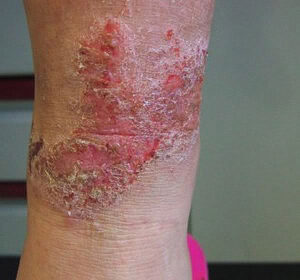

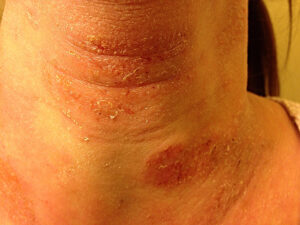
Round, coin-shaped spots on your skin. It looks very different from other types of eczema and it can itch a lot.
SYMPTOMS
- Round, coin-shaped spots form on your skin.
- The spots may itch or become scaly.
CAUSE
- Nummular eczema can be triggered by a reaction to an insect bite or by an allergic reaction to metals, chemicals or certain drugs. Dry skin can also cause it. You’re more likely to get this form if you have another type of eczema, such as atopic dermatitis.
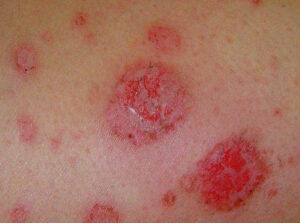


Stasis dermatitis happens when fluid leaks out of weakened veins into your skin. This fluid causes swelling, redness, itching, and pain.
SYMPTOMS
- The lower part of your legs may swell up, especially during the day when you’ve been walking.
- Your legs may ache or feel heavy.
- You’ll likely also have thick and ropey varicose veins in your legs.
- The skin over those varicose veins will be dry and itchy.
- You may develop open sores on your lower legs and on the tops of your feet.
CAUSE
- Stasis dermatitis happens in people who have blood flow problems in their lower legs. If the valves that normally push blood up through your legs toward your heart malfunction, blood can pool in your legs. Your legs can swell up and varicose veins can form.

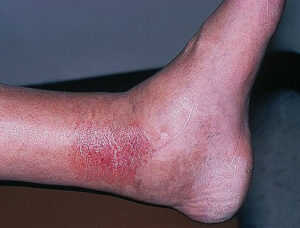

Psoriasis is a skin disorder that causes skin cells to multiply up to 10 times faster than normal.
SYMPTOMS
- Plaques of red skin, often covered with silver-colored scales. These plaques may be itchy and painful, and they sometimes crack and bleed. In severe cases, the plaques will grow and merge, covering large areas.
- Disorders of the fingernails and toenails, including discoloration and pitting of the nails. The nails may also crumble or detach from the nail bed.
- Plaques of scales or crust on the scalp.
- They can grow anywhere, but most appear on the hands, scalp, elbows, knees and lower back.
CAUSE
- The biggest difference between eczema and psoriasis is the underlying causes. Psoriasis is an autoimmune disease, meaning your immune system is dysfunctional and your skin cells grow too fast. The cells start to pile up on the top of the skin, forming the silver scales.
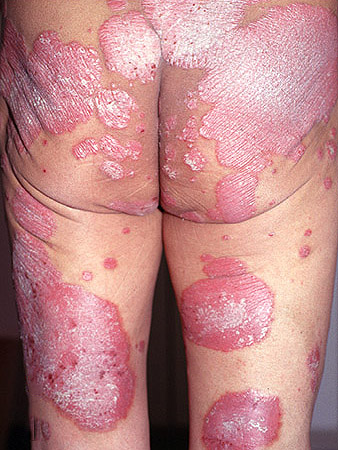
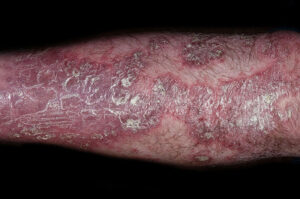

Real People, Real Results!
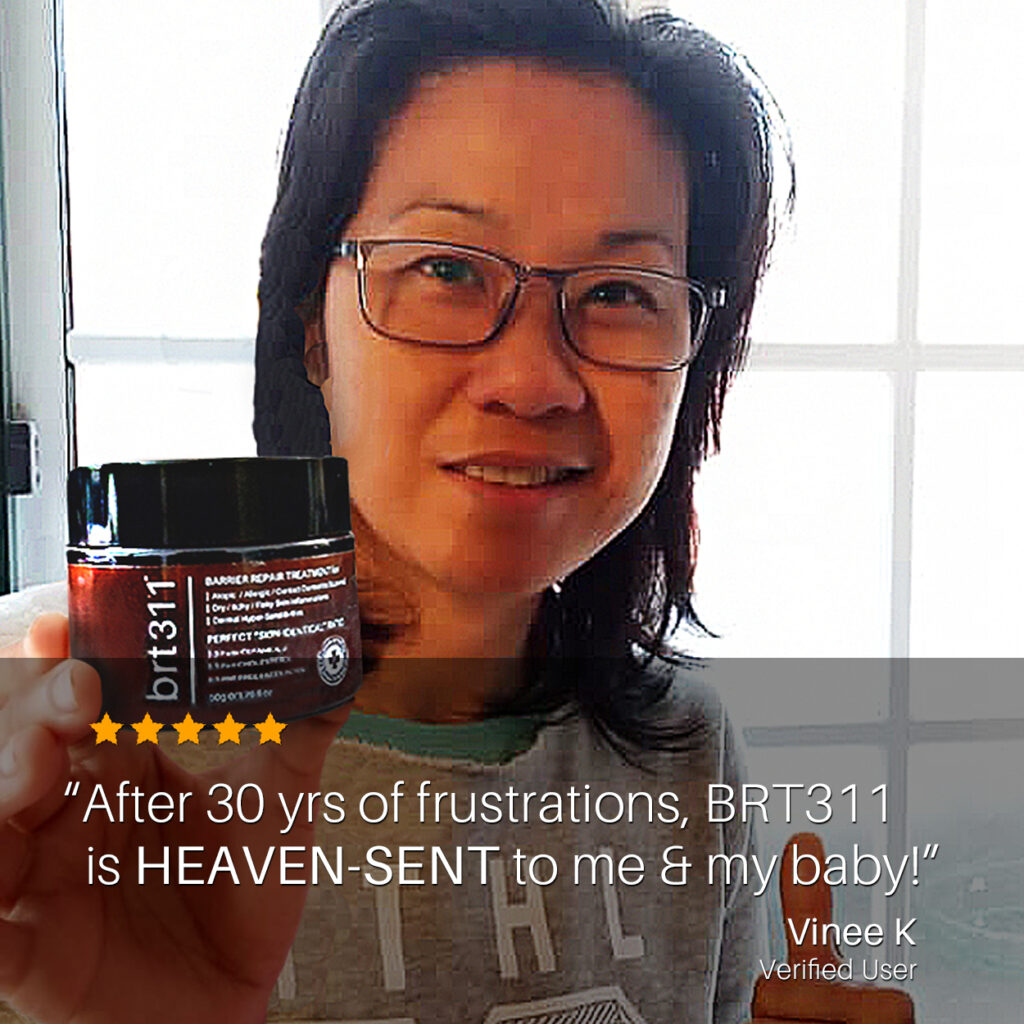
![]()
After struggling with severe eczema & let down by uncountable meds for the past 30 yrs, I was cynical & distrustful. But witnessing how my colleague’s “just-as-bad” skin recovered like magic, I immediately ordered. In just days, my skin cleared up drastically & I’m now even applying it on my 8-mth old baby with fantastic results. TQVM, you’ve been HEAVEN-SENT! 😘
Vinee K
Verified User

